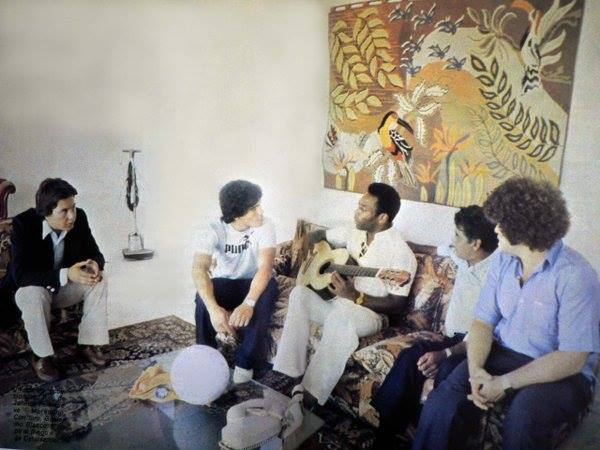As a skinny seventeen-year-old, Pele exploded onto the international scene in the summer of 1958, from the pastures of the World Cup stadiums in Sweden. He went on to straddle the transition of football from a game to a serious business venture, breaking cultural and racial boundaries, his true potential barely registered by the grey images of black and white TV highlights of his first major contest.
Maradona was delivered into the world two years later, his early days in a Buenos Aires shanty town, mythologised with the cry ' Gooool!' uttered by his mother as she gave birth to him in a hospital named in memory of the radical politician Evita Perón, part of a legend foretold.
By then Pele was already on his way to joining the pantheon of the sporting greats, the first black footballer to do so, challenging a space that in the 1950's had belonged to the Argentine born Alfredo di Stefano, the key player in Real Madrid's unrivalled decade as the best club in the world during the Franco years.
Real Madrid fans eulogised La Saeta Rubia the 'blond arrow, ' watching in awe Di Stefano's ability to defend his own goal and then seconds later go on the offensive, leaving behind him a whole team in a way that transformed all imaginable systems.
Pele declared his own brand of genius, a simple expression of joy in the beauty of the game, the 'jogo bonito.' The goal that he himself recalled in later life as one of his own all-time favourites, because he was still very young and "none one had seen a goal that before", was the third in the final against the host nation in 1958. It showed vision, effortless control and balance, athletic nimbleness and grace, and powerful execution, a combination of Di Stefano, Johan Cruyff, Maradona, and Messi.
The next few years would see Pele's star rising with his Brazilian club Santos with further confirmation of his talent, winning his second world cup in Chile in 1962 (although spending part of it as a passenger because of a groin injury as no substitutes were allowed ) , then failing to succeed in the next World Cup in England in 1966, before shining with real collective brilliance as Brazil became world champions again in Italy in 1970.
While English fans lamented their team's failure to defend their title, one of the enduring images of sportsmanship in the the 1970 World Cup was that of Pele embracing Bobby Moore as he swapped shirts with the English captain, after the Group C match which Brazil won . The tournament was televised for the first time in colour, making the encounter between the 'black pearl' and the 'blond gentleman' particularly resonant of mutual respect and decency.

In 1979 two years after Pele had retired as a player, earning more than he had done in his entire footballing career, with the New York Cosmos, Maradona had become the latest teenage prodigy to take the first step into the hall of football fame .
In June that year, the 18-year-old Maradona, playing only in his fifth international after being judged by coach Menotti as too immature to play in the 1978 World Cup , was the undisputed star of Argentina's victory over Scotland in a packed Hampden Park in Glasgow.
Maradona showed an early example of his hallmark genius destroying the Scottish defence with a series of feints and dummies before whipping the ball between the keeper and his left-hand post. As later recalled by Scottish international Denis Law, it was the cheekiest goal ever scored in the stadium- 'strong, brave, and skilful, an individual who works for the good of his team."
Later that year Maradona led Argentina to its first World Youth Championship in Tokyo, a major breakthrough in his career that would greatly enhance his commercial value, as he went on to sign with FC Barcelona two years later. Before doing so Maradona made a much-publicised pilgrimage to Brazil to fulfil one of his childhood dreams: that of sitting and talking to Pele, in an encounter of mutual respect between dauphin and King.

Three years later , the relationship soured during the World Cup in Spain. Maradona was red carded in an ill-tempered encounter as Argentina lost its game against Brazil 1-3 and were eliminated .
Maradona, who was already developing a paranoid view of anyone who criticised him, was furious when Pele wrote a guest column in the biggest selling Argentine newspaper Clarin suggesting that the Argentine's talents as a footballer were being undermined by his failings as a human being. "My main doubt is whether he (Maradona) has the sufficient greatness as a person to justify being honoured by a worldwide audience," wrote Pele.
It was in Barcelona where the Argentine went to live and play after the World Cup, that Maradona took cocaine for the first time, thus beginning a tempestuous roller-coast life between his brilliance on the pitch and his scandalous life off it.
It marked his difference with Pele, whose devout Catholic faith survived three marriages, and who never suffered from the nemesis of the Argentine who squandered his talent through drugs and alcohol abuse.
In time it was Maradona who would lay claim to being the true people's champion turning the underdogs of Italian league Napoli into champions and taking Argentina to its second World Cup victory, in Mexico in 1986, before aligning his world view to that of Fidel Castro 's in Cuba.
In 1995, after his expulsion from the World Cup in the US after testing positive for a banned substance, Maradona pursued a short-lived campaign which ended in failure to form a world players' union in defiance of FIFA.
While doing so, he tried to belittle Pele's reputation, for a while caricaturing the Brazilian as a puppet of the football establishment, an uncritical apparatchik of FIFA who avoided political controversy.
Only in 2004, after Maradona, recovering from a heart scare from a suspected cocaine overdose, re-emerged hosting a celebrity TV show in his native Argentina, did the two football stars agree to put on a public display of reconciliation.
In the opening show, Maradona and Pele exchanged personally autographed national football shirts, headed a ball to each other for nearly a minute and shared a Tango song together-with Pele on guitar and Maradona singing.
Pele then went on to describe Maradona as an example of how to beat addiction, calling him an inspiration for his own son who had just been jailed on a drugs-related charge. Maradona shed tears, although Pele's judgement turned out to be premature, as the Argentine resumed his descent from grace into deepening ill-health, made worse by his years of drug abuse.
In November 2020, Maradona died in his sleep , just turned sixty, after suffering acute heart failure which sparked an unresolved controversy among friends and foes as to who had been responsible for his death.
Pele died in December 2022, after stoically battling with cancer, aged 82, his extended family united at his death bed in a dignified show of love, solidarity, and respect. His was a longer life and arguably a more exemplary one than Maradona's, even if the legacy of both was that of being considered the greatest in their separate time, just as Messi would be considered by many fans to be the greatest of his time, despite being a less interesting personality than the other two greats.
For now, it is Pele and Maradona who have passed into history with Pele's faith leaving us with an epitaph of a generous spirit . As Pele said on hearing of Maradona's death:
"What sad news. I lost a great friend, and the world lost a legend. There is still much to be said, but for now, may God give strength to the family. One day, I hope we can play football together in heaven."
Now that would be a Jogo Bonito.

















